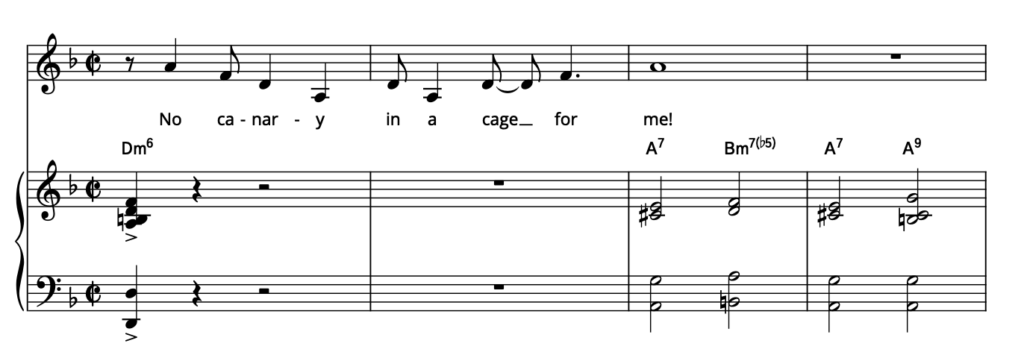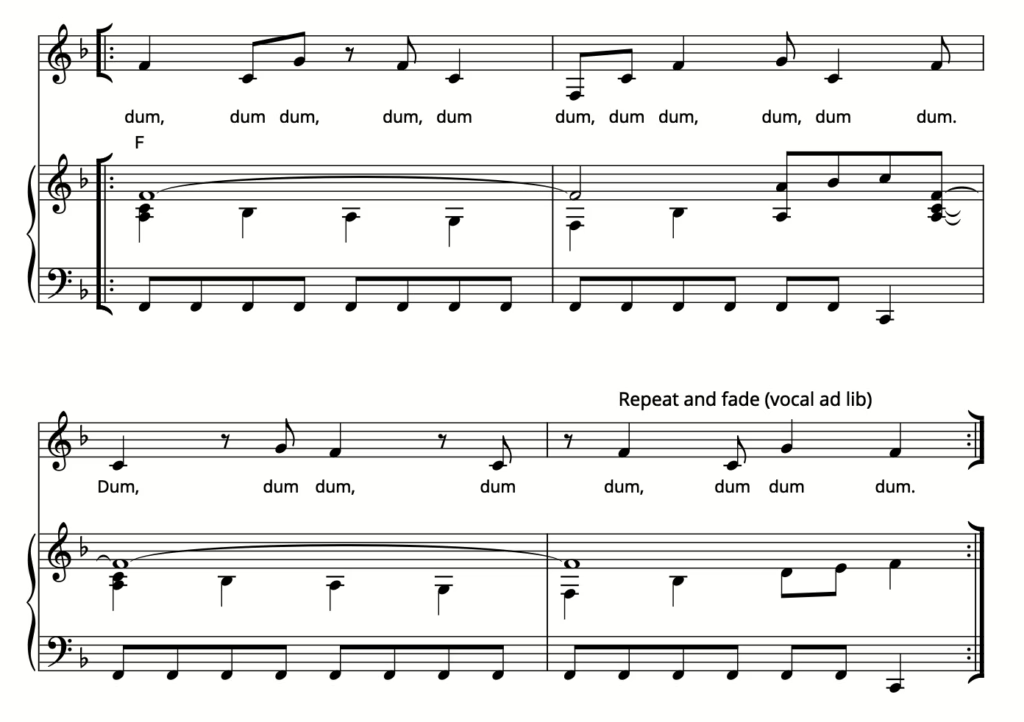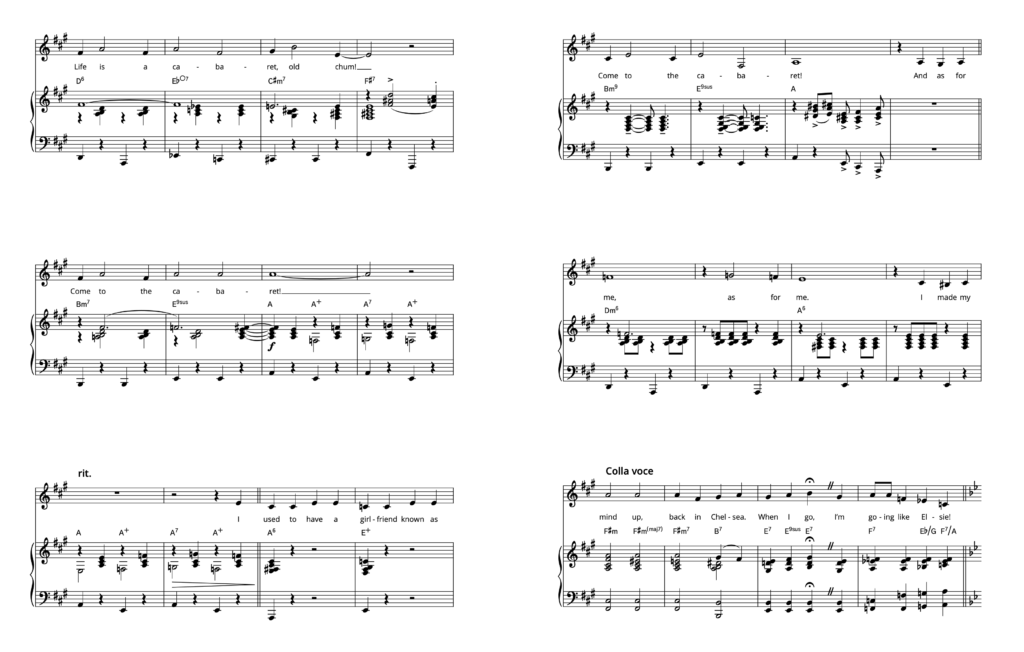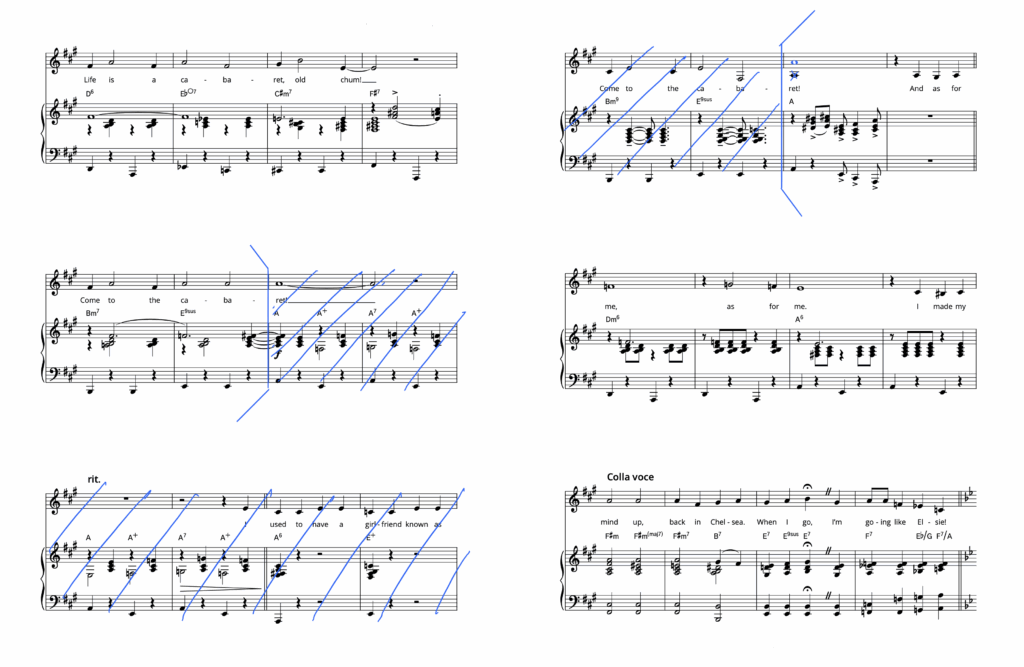Your agent sends through a casting breakdown for a dream job, and the panel wants to see a 60 second cut of a song you’ve never sung in an audition before, accompanied by a pianist you’ve never met. Even worse, the audition is only a couple of days away! As a professional audition pianist, I’ve seen it all when it comes to auditions. It’s my job to help your audition go well, and there’s a few things that you can do to help me help you, starting with making sure that you’ve got a neat cut of your audition song!
The goal is to make it as easy as possible for your accompanist to follow you during your audition, so you should mark up the music as effectively as you can. You don’t need to be an expert in music theory to understand how to cut your sheet music either!
If you get to the end of this post, and it still all seems a little too much, then you should know that cutting sheet music is a service that I offer here as well!
Why am I cutting my song for an audition?
The first question I would always ask is: why are you cutting this sheet music? Have you been told that you’re only allowed to sing 32 bars? Does the middle section of your song sit just outside your range? Do you feel like only a short section of the song is needed to show you off completely? These are all very valid reasons for wanting to cut a piece of sheet music. As long as you have an answer, then that’s great! In an ideal world, we’d all get to hear the whole song the way that the composer and lyricist wrote it. It took them time to write a beginning, middle and end. Sometimes, sadly, we’re a bit pushed for time, so we might need to skip the beginning, and start halfway through the story of the song.
The casting team want a clear picture of your vocal ability, and what you can bring to the role as a performer. And they want it in less than a minute.
It will depend a little bit on the audition. Make sure you’ve read the audition breakdown closely to see what the panel wants to hear from you. You might be asked for a 32-bar cut. Sometimes, you’ll be asked for a song under two minutes. Other times, there might be no restrictions on there at all — it’s still good to have a cut version of your song to offer, just in case.
All of the suggestions below assume that you’ve already chosen the song that you’re going to sing, and you’ve got a copy of the sheet music ready to go. If you’re not sure where to find sheet music, good sites to use as a starting point include MusicNotes and SheetMusicDirect. NewUKMusicals is a good resource specifically for songs by UK Musical Theatre composers. If you’re looking for songs from new musicals, then I’d also suggest seeing if the composer has their own site where they sell music, so that you can support them directly.
Step One: Deciding on an audition cut
How do I want my cut to start?
How much of an introduction do you need at the start of the song? You might be happy with just a ‘bell note’, or perhaps you’d prefer if the pianist played a few bars to set the tone. These are both completely valid options, but make sure that you’ve marked it up well.
In the example below, the lyrics start immediately after the pianist plays the first chord. If you don’t know when it’s coming, you might miss your entrance rhythmically. Worst case scenario, you might not hear where your first note sits in that quick chord!

It’s absolutely fine if you’re confident with that as the start of your cut, but you might perhaps ask the pianist to play a bell note (the first note you’re going to sing). You can even ask for the first phrase of the song before they start playing. so that you know exactly where you’re starting your song. There are examples of all three of those openings below.
How do I want my cut to end?
You might be very certain about how your audition will start, but how does it end? A lot of pop songs might have a ‘repeat and fade’ at the end, which could be embarrassing in an audition as you start singing quieter and quieter, unsure when to end. Often times, a song will end with a clear ‘button’. A button is a clear end to the song, usually either a chord, or a single low note (as though someone’s plucked a low note on a double bass!).

As an example, Fleetwood Mac’s “Everywhere” ends with a repeat and fade, and even suggests vocal ad libs over the top. The performer doesn’t sing what’s written, but what they feel works musically instead. Unless you’ve marked it up nicely, your pianist will be trying to guess when you’re ready to end the song, which could go on for longer than you’re wanting it to!
Does this cut still make sense dramatically?
Especially with musical theatre songs (and sometimes pop songs, but to a lesser extent), there will be a clear storyline through the song. Make sure that the sections that you’re choosing to cut out aren’t crucial to the storytelling. The panel will want to see how you’re acting whilst you’re singing, and conveying that story to the audience. It only makes your job harder if you’re having to make references to things you’ve removed from the song!
Read through the lyrics before and after you make a cut. What are the important story beats? Are you singing about something that will confuse your audience now?
Do I need an instrumental section?
Sometimes there might be a section in the middle of your song that you’re not singing during, but there’s a lovely instrumental. Personally, I’d suggest finding a way around this, as the audition panel aren’t there to hear me playing piano (they’ve heard me all day!) they want to hear you sing. Sometimes, you might need a small section to help navigate a key change before the vocal line comes back in, and that’s totally fine.
There are instances where leaving the instrumental section in your cut is the ‘right’ choice — you might have planned out a routine that goes with that music, especially if it’s a character song and you’ve got a small comedy bit to do during this moment.
Am I singing the right lyrics?
Check that your sheet music has all of the lyrics that you’re going to sing in your audition. If you’ve decided that you don’t want to sing the first verse, then cross out those lyrics and make sure that the second verse’s lyrics are written there instead. If something goes wrong during your audition, especially if I don’t know the song very well, my first port of call is the lyric line, as that lets me know exactly where you’re at in the song — if you’re not singing what’s on the page though, I’ll be completely lost.
This also applies if you’re doing comedy auditions where you’ve completely re-contextualised a song. These auditions can be absolutely brilliant, as you get to show the panel that you’ve really put thought into your characterisation and made it relevant to the show, but if you haven’t put those lyrics into the sheet music, then it’s going to be very difficult for me to follow you (no matter how good your scansion might be!)
Could I find my way through this audition cut?
You want to be as confident as you can knowing how your cut works, and where the jumps are, what’s ‘different’ about your cut. More importantly, you need to be able to communicate this effectively to your accompanist on the day. Make sure that you understand the changes that you’ve made, so that you know what to point out. Is there a D.S. al Coda marking (which means to go back to dal segno, ‘the sign’, and then play until you need to go to the Coda) , but you’ve cut out the section that I’m supposed to go back to? If your song has a section with repeats marked as first or second time, do you want to do that repeat, or are you skipping straight past it to the next section?
Step Two: Making the cut
Choosing where to cut
Let’s use Cabaret from Kander and Ebb’s Cabaret as an example. You’ve got some auditions coming up where this song is a great choice. The middle of the song has a verse about Sally Bowles’ ex-London flatmate, Elsie. Let’s say you didn’t feel like that section was important to the song, and it didn’t show you off very well, or that it just adds a little too much time to your audition. Either way, the verse has to go!
For the sake of this example, imagine that there’s a couple of extra pages in between the two pages shown below – the whole verse about Elsie continues after ‘I used to have a girlfriend known as…‘. The next section that you might want to sing is the lead up to the ending, which starts at ‘And as for me, as for me.’ We’ll call the two sections “A” and “B”.

The lyrics of the “A” section (on the left page) read, ‘Life is a cabaret, old chum! Come to the cabaret’. The lyrics of the “B” section (on the right page) read, ‘And as for me, as for me, I made my mind up back in Chelsea, when I go, I’m going like Elsie‘.
As a sidenote, this isn’t a perfect choice. You’d be referring to Elsie, who is introduced in the section that you’re going to cut. It’s not the end of the world by any stretch, as it’s such a passing moment, but an additional consideration might be changing those few lyrics to something else that still works dramatically.
You might notice that the lyrics just before the “B” section begins are the same as the end of the “A” section — this is a handy thing to notice, because it means it could be easy to cut there. Both of those choruses end with the same lyrics, and even a similar phrase.
A more advanced step (feel free to skip this bit, I won’t be offended!) would be to double-check that this cut might work by looking at the chord symbols. Chord symbols are the collection of letters, numbers, and sometimes shapes above the piano part; they might not make sense unless you know what you’re looking at, but they’re useful for pianists! In the “A” section, you’ll notice that the chord symbols underneath ‘come to the cabaret’ are Bm7, E9sus, and A. The chord symbols for the three bars, before section “B” underneath the same lyrics, are Bm9, E9sus, and A. Although they’re not identical, they’re incredibly close (the important part to look at is the B, E, and A), and that suggests that cutting between those two sections would probably work!
Marking up your audition cut
Now that you’ve identified a good place to cut from and to, how exactly do you mark it up? I’m a fan of large brackets, and plenty of crossing out. I’ve marked up the score below in blue so that it’s clear to see, but any colour is fine (including black pen, or grey pencil).

I’ve cut halfway through the word ‘cabaret’ so that the accompaniment leading into the new section will be what I’d get if I hadn’t put a cut in there. I know that it’s going to work because the choruses end the same way every time (and additionally, I checked the chord symbols as above). You might also notice that I’ve crossed out the lower note on the final syllable of ‘cabaret’ and written a higher note in — this is because I’m going to continue singing the old phrase, instead of cutting the vocal line as well.
The large brackets indicate very clearly that the music ends in one place, and picks up in another (notice the direction that the ‘arms’ on the brackets are going; towards the music!). Any bar that has music that isn’t being sung is completely crossed out, and I’ve made sure that the crossing lines aren’t going into any bars that I want played.
If you’ve crossed out an entire page of music, don’t put it into the cut at all. This will save the pianist having to flip forward one or two (or sometimes more!) pages of crossed out music to try and find where you’ve cut to.
Step Three: Checking your cut
Congratulations! You’ve decided on a cut, and you’ve marked it up. It’s always good practice to make sure that your cut definitely works as you’re expecting it to, though. If you’re able to read music and play it yourself, then give it a go. Would you be able to follow this music if it was put in front of you for the first time?
If you aren’t able to do that, then you can always send your cut to a pianist, and ask them to send you a recording of the score. This has the advantage of giving you a practice track, so you’ll know what to expect on the day!
If you’ve cut your music yourself, be prepared to answer any questions that your audition pianist might have for you on the day about your cuts — they might just need a little clarity for themselves on how your cut works.
Step Four: Put your audition cut together
Putting all of this together can be done in a few ways. There’s always a bit of debate around whether you should tape music or put it into a folder. I personally prefer taped music, but I’m happy to play from a folder, or even an iPad or tablet.
I would always suggest having your sheet music printed on loose-leaf, single-sided A4 paper. Make sure that the full page of music is printed properly, with a margin around all sides. Some printers may cut off the edges or bottom of the music, which makes it very difficult for a pianist to know what to play.
When you’re taping your music together, make sure to leave a small gap between pages so that it’s easy to fold up, accordion style. Start by laying out all your pages face up, and tape the adjacent edges together. Then, turn it over carefully, and repeat. Taping both sides of the sheet music means that it won’t be sticky on the back. If you’ve done it correctly, it should fold easily in both directions. This will mean that the pianist is able to decide where their page turns will be, which they will appreciate.
If you’re using a folder, make sure that it isn’t too bulky to fit on a piano music stand; they’re often quite thin pieces of wood that aren’t designed to support your entire rep folder! A small folder with a couple of songs won’t be an issue. Try to minimise page turns where possible, and make sure that the sleeves of the folder don’t stick together when turning pages. Another consideration is making sure that the sleeves of your folder aren’t reflective, as this can make the music hard to read.
Similarly, I’ve seen plenty of people bringing iPads into auditions. Some pianists might not be used to playing from an iPad, so it’s best to make sure before the audition if possible. An app that a lot of musical directors and auditions pianists will likely be used to is ForScore, but any .pdf reader app will make it easier for the pianist to use. Make sure that your tablet is charged, you know how to turn pages forwards and backwards in case the pianist asks (usually either a swipe or a tap), and turn on Do Not Disturb!
Step Five: Ace your auditions!
A good cut of your music will be clear and concise. It should contain moments to show off your vocal strengths, as well as your characterisation. You’ve got a short introduction that gets you straight into the tone of the song, you’ve skipped all the parts that don’t showcase your performance, and your ending is confident and memorable.
You’ve now got a perfectly cut piece of music to add to your repertoire that’s properly marked up, and you can walk into that last-minute audition with confidence! Break a leg!